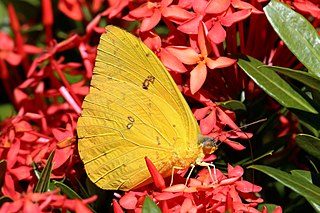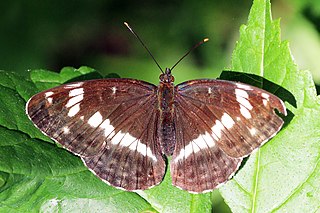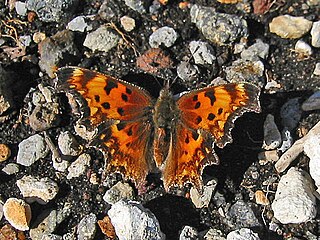
Zerene eurydice, the California dogface butterfly, belongs to the family Pieridae and is a member of a genus closely related to the genus Colias. A study that collected mitochondrial DNA from various Colias butterfly species found that Z. eurydice had decreased divergence from the ingroup, highlighting how closely related these two genera are. This species is endemic to California, and is California's state insect. The California dogface butterfly varies in its wing color and pattern.

Phoebis sennae, the cloudless sulphur or cloudless giant sulphur, is a mid-sized butterfly in the family Pieridae found in the Americas. There are several similar species such as the yellow angled-sulphur, which has angled wings, statira sulphur, and other sulphurs, which are much smaller.

The viceroy is a North American butterfly. It was long thought to be a Batesian mimic of the monarch butterfly, but since the viceroy is also distasteful to predators, it is now considered a Müllerian mimic instead.

Limenitis camilla, the (Eurasian) white admiral, is a butterfly of the family Nymphalidae. It is found in woodland throughout southern Britain and much of Europe and the Palearctic, extending as far east as Japan.

Limenitis arthemis, the red-spotted purple or white admiral, is a North American butterfly species in the cosmopolitan genus Limenitis. It has been studied for its evolution of mimicry, and for the several stable hybrid wing patterns within this nominal species; it is one of the most dramatic examples of hybridization between non-mimetic and mimetic populations.

The hoary comma is a species of butterfly, common in boreal North America from Alaska, across southern Canada to New England and the Maritime Provinces and south to New Mexico from the Rocky Mountains to the Pacific Ocean. The wings have a distinctive ragged edge.

Lorquin's admiral is a butterfly in the Nymphalinae subfamily. The butterfly is named after Pierre Joseph Michel Lorquin, a French naturalist who came to California from France during the Gold Rush, and made important discoveries on the natural history of the terrain.

The American snout or common snout butterfly is a member of the subfamily Libytheinae in the brush-footed butterfly family, Nymphalidae. This species is found in both North and South America. The larval host plants are Celtis species on which the eggs are laid singly. Massive migrations of this species often attract attention in the Texas and Mexican newspapers.

Adelpha californica, the California sister, is a species of butterfly in the family Nymphalidae. They are common in California, but can also be found in western Nevada and Oregon, as well as in northern Baja California. The upper surfaces of their wings are dark brown to black with wide cream white bands dissecting both wings and two orange patches near the tips of the forewings. The underside is variously colored with browns, blue, orange, and white. A. californica is unpalatable to predators and is part of a large mimicry complex.

The eastern tailed-blue or eastern tailed blue, also known as Everes comyntas, is a common butterfly of eastern North America. It is a small butterfly that is distinguished from other blues in its range by the small thin tail.

The poplar admiral is a butterfly in the subfamily Limenitinae of the family Nymphalidae.

Limenitis reducta, the southern white admiral, is a butterfly of the family Nymphalidae.

Chlosyne gorgone, the gorgone checkerspot, is a species of Nymphalinae butterfly that occurs in North America.

Anatrytone logan, the Delaware skipper, is a North American butterfly. It is a member of the subfamily Hesperiinae, the grass skippers. This skipper ranges from the southern Canadian Prairies and southern Ontario through the midwestern and eastern United States.

Callophrys augustinus, the brown elfin, is butterfly of the family Lycaenidae. It is found from Newfoundland north and west through the northern United States and the prairie provinces to Alaska. To the south it ranges in Appalachian Mountains to northern Georgia and northern Alabama, further south through the western mountains to northern Baja California in Mexico. Subspecies iroides is known as the western elfin.

Satyrium liparops, the striped hairstreak, is a butterfly of the family Lycaenidae described by John Eatton Le Conte in 1833. It is found in North America, from the Rocky Mountains south from southern Canada to Colorado, east to Maine and south to Florida.
Heliopetes ericetorum, the northern white-skipper, is a butterfly of the family Hesperiidae. It is found in North America from eastern Washington south to western Colorado, southern California, Arizona and Baja California in northwestern Mexico. The habitat consists of open woodland, chaparral, dry washes, desert mountains and arid lands.


















